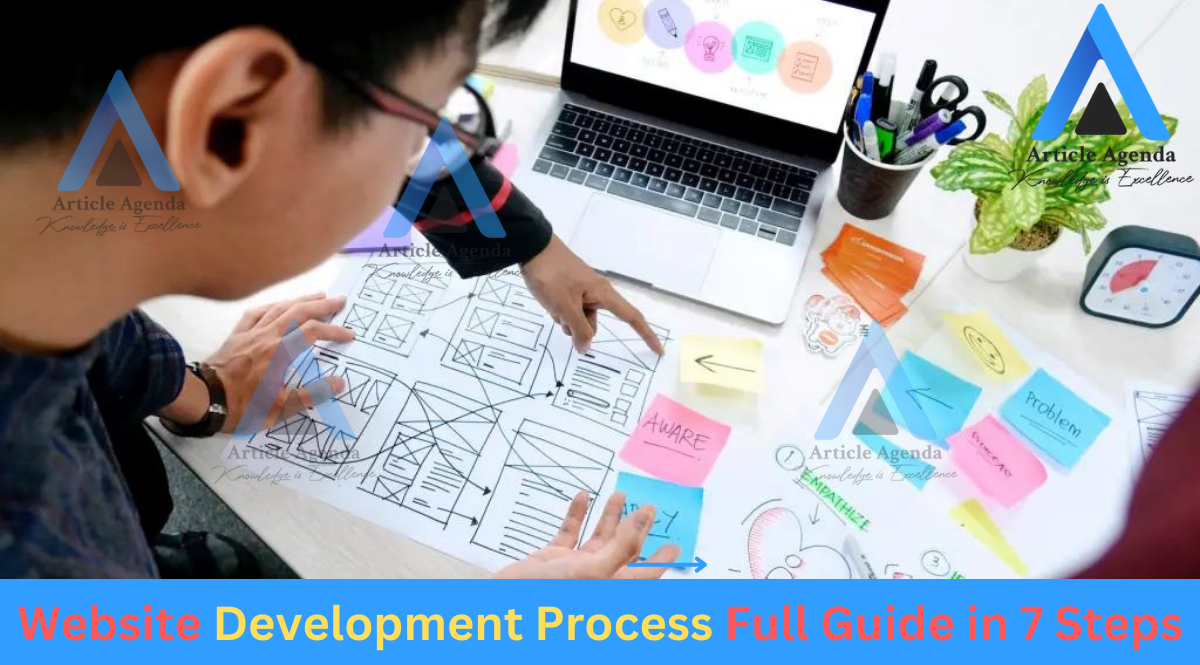Introduction to the Website Development Process
In today’s digital age, having a solid online presence is crucial for businesses. A well-designed and functional website can be a powerful tool to attract and engage customers. However, website development can be complex and overwhelming if not approached systematically. This guide will take you through the seven essential steps in the website development process. By following these steps, you can ensure your website’s successful creation and launch.

Table of Contents
- Introduction to the Website Development Process
- Step 1: Defining your Website Goals and Objectives
- Step 2: Planning and Research
- Step 3: Designing the Website Layout and Structure
- Step 4: Development and Coding
- Step 5: Testing and Quality Assurance
- Step 6: Launching the Website
- Step 7: Website Maintenance and Continuous Improvement
- Common Challenges in the Website Development Process
- Conclusion
Step 1: Defining your Website Goals and Objectives
Before embarking on any website development project, clearly defining your goals and objectives is essential. What do you want your website to achieve? Are you looking to generate leads, increase online sales, or provide information to your customers? You can align your website development efforts with your business objectives by establishing clear goals. This will help you make informed decisions throughout the development process and ensure that your website is designed to meet your specific needs.
Next, you need to identify your target audience. Who are your website visitors? What are their needs and preferences? Understanding your audience will enable you to create a user-friendly website that resonates with your target market. Conducting market research and analyzing your competitors’ websites can provide valuable insights into what works and what doesn’t in your industry.

Step 2: Planning and Research
Once you clearly understand your goals and target audience, it’s time to move on to the planning and research phase. This step involves conducting a thorough analysis of your business requirements and the technical aspects of website development Process.
Start by creating a detailed sitemap that outlines the structure and navigation of your website. This will help you visualize how different pages and sections will be interconnected. Consider the user experience and ensure your website is intuitive and easy to navigate.
Additionally, research and choose your website’s content management system (CMS). A CMS allows you to easily create, edit, and manage the content on your website. Popular CMS options include WordPress, Drupal, and Joomla. Evaluate their features and select the one that best suits your needs.
Step 3: Designing the Website Layout and Structure
Design plays a crucial role in creating a visually appealing and user-friendly website. In this step, you will work on designing the layout and structure of your website. Start by creating wireframes or prototypes to visualize your website’s overall look and feel. This will help you determine the placement of key elements such as headers, navigation menus, and call-to-action buttons.
Next, create a visually appealing design that aligns with your brand identity. Choose a color scheme that represents your brand and evokes the desired emotions in your visitors. Select appropriate fonts and typography that enhance readability. Remember to prioritize responsive design, ensuring your website looks great on all devices, including desktops, smartphones, and tablets.
Read More : WordPress Website Design & Development Services
Step 4: Development and Coding
Once the design phase is complete, it’s time to bring your website to life through development and coding. Start by setting up a development environment that mimics your live website environment. This will allow you to test and make changes without affecting the live site.
Begin coding the front end of your website using HTML, CSS, and JavaScript. This involves translating the design elements into code and ensuring the website is interactive and responsive. Pay attention to load times, image optimization, and browser compatibility to provide a seamless user experience.
Simultaneously, work on the back-end development, which involves setting up servers and databases and integrating any necessary functionality. If you’re using a CMS, this step will include installing and configuring the chosen platform. Optimize your website for search engines by implementing proper meta tags, keyword optimization, and SEO-friendly URLs.
Step 5: Testing and Quality Assurance
Before launching your website, it is crucial to test its functionality and performance thoroughly. This step involves conducting various tests to identify and fix any issues or bugs. Start by checking the compatibility of your website across different browsers, devices, and operating systems. Ensure all the links are working correctly and the website is easily navigable.
Perform load testing to assess how well your website handles high-traffic volumes. Slow load times and errors can lead to a poor user experience and negatively impact your search engine rankings. You can use tools like Google PageSpeed Insights to identify areas for improvement.
Furthermore, conduct a comprehensive review of the website’s content to ensure accuracy and relevance. Check for spelling and grammar errors, broken images, and outdated information. Test any interactive features like forms or shopping carts to ensure they function correctly.
Step 6: Launching the Website
Congratulations! Your website is now ready for launch. Before making it live, create a backup of your development environment and take necessary precautions to avoid any potential downtime or technical glitches.
Choose a reliable web hosting provider and register a domain name that aligns with your brand. Set up the DNS settings to point your domain to the hosting server. Upload your website files to the server and configure any required databases and email accounts.
Once everything is set up, conduct a final round of testing on the live website to ensure all functionalities work as expected. Make any necessary adjustments and fixes before announcing the launch to the public.
Step 7: Website Maintenance and Continuous Improvement
Launching your website is just the beginning. You must prioritize regular maintenance and continuous improvement to keep your website running smoothly and effectively. This involves monitoring your website’s performance, updating content, and implementing security measures.
Regularly review your website analytics to gain insights into visitor behavior and identify areas for improvement. Make data-driven decisions to optimize your website’s performance and user experience. Update your content regularly to provide fresh and relevant information to your visitors.
Additionally, stay updated with the latest web design and development trends to ensure your website remains competitive. Regularly check for security vulnerabilities and implement necessary measures to protect your website and user data.
Common Challenges in the Website Development Process
While the website development process can be exciting, it has. Some common hurdles include unrealistic timelines, scope creep, and developer communication issues. To overcome these challenges, it is essential to have a clear project plan, establish open lines of communication, and set realistic expectations from the start.
Conclusion
The website development process is a multi-faceted journey that requires careful planning, research, and execution. By following the seven steps outlined in this guide, you can navigate the complexities of website-development and create a website that meets your business goals and engages your target audience. Website-development is an ongoing process, and continuous improvement is critical to staying ahead in the competitive online landscape. So, start building your website and unlock its potential to drive your business forward.
Latest Post
-
Smart Home Appliances in the UAE: Revolutionizing Modern Living
The UAE has long been recognized as a hub for innovation and technological advancement, and the adoption of smart home appliances is no exception. As the nation embraces the concept of smart homes, residents are experiencing a transformation in their daily lives, characterized by increased convenience, efficiency, and sustainability. This article explores how smart home…
-
(Artificial Intelligence) AI and ML (Machine Learning) : Transforming the Future
Artificial Intelligence (AI) and Machine Learning (ML) are two of the most transformative technologies of our time. They are reshaping industries, driving innovation, and opening up new possibilities in ways previously unimaginable. This article explores the fundamentals of AI and ML, their applications, and their profound impact on various sectors. Understanding Artificial Intelligence (AI) What…
-
Digital Marketing Services: Transforming Your Business in the Digital Age
In today’s digital-first world, businesses must leverage digital marketing services to remain competitive, attract customers, and drive growth. Digital marketing encompasses a broad range of tactics and strategies aimed at promoting products or services through digital channels. This article delves into the various types of digital marketing services available, their benefits, and how businesses can…





I like this website very much, Its a rattling nice post to
read and get information.Raise blog range